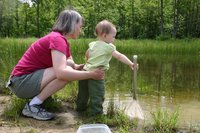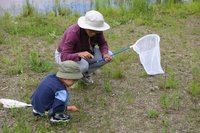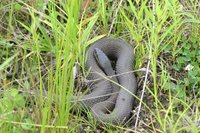Goose Pond Mountain Created Wetlands, 09 June 2006

Laurel reflects on our outing at Goose Pond...
Encircled by hills and surrounded by old field and wetland, yet never more than a five minute walk from the parking lot, Goose Pond Mountain Area is an ideal spot for babies and young children.
It rained heavily over the past few days. The results of such weather were easy to see underfoot. Clusters of mushrooms had emerged from the sodden soil to decorate the edges of our path. Lots of tall, brown-gilled parasols and tons of little brown mushrooms were scattered about, but despite taking a class in mushrooms in grad school, these were all a bit too difficult to identify from memory.
It rained heavily over the past few days. The results of such weather were easy to see underfoot. Clusters of mushrooms had emerged from the sodden soil to decorate the edges of our path. Lots of tall, brown-gilled parasols and tons of little brown mushrooms were scattered about, but despite taking a class in mushrooms in grad school, these were all a bit too difficult to identify from memory.

Anderson, a three-year-old, was on a mission to get to the pond. Sybil, his mother, mentioned that the last time they had dropped by Goose Pond, the large rafts of toad tadpoles that her sons had so enjoyed catching the week before had disappeared. I mentioned that my son, Sebastian, had noticed the same thing. We’d hoped to come on a day like the one Kat witnessed last year. The first day we walked at Goose Pond together Kat had shared her memory of hundreds of tiny toads hopping across the gravel path. But we did not visit the pond every day last week and somehow missed any mass emergence.
All three boys had benefited from the ease of capture of this tadpole species over the past weeks. In the shallow water, the toad tadpoles congregated in large groups. The boys didn’t have to get their feet wet to fetch a netfull for observation. We watched them grow in size and develop legs in the course of a few weeks. (Generally, I find toads the all around best amphibian for children to discover; they are slow in every stage.)
The clouds were swirling, patterns making a thrilling backdrop to the hills and reflecting in the still waters of the three ponds. We talked as we walked and scanned the trailside. The rocky fill was growing with a variety of native plants and non-native weeds. Kat spotted a butterfly.
Her capture of a little wood satyr—the butterfly not the mythological beast—was quick and efficient. So was the identification. Kat checked the spots on the underside of the grayish wings against the field guide to be sure, but we’d caught this species before in another location. It took the spectacular arrival of the orange and black monarch to put a full stop to our progress toward the pond. Butterfly nets were drawn and adult women stalked their prey as the monarch flew from flower to flower. We are green at this, and our first attempts were often failures. These would be followed by wild flailing and sometimes modified curses. This butterfly seemed to anticipate every move of the net. Chasing the creatures was so exhausting that it hardly seemed worth going after the painted lady butterfly that nectared nearby.
We tucked our nets back into our strollers and made our way down to the most shallow of the three ponds. On the way, Sybil and Anderson discovered a moving pebble. It was a newly transformed toad, only a half centimeter long and so well camouflaged that we had to step gingerly thereafter for fear of inadvertently squashing one.
Anderson, Kat and Sybil collected four of these and put them in the Tupperware container I’d brought for viewing pond animals. It was easy to see their minute limbs and mottled backs. It also made it possible to lift them up to show Acadia in her stroller. Previously very excited by swimming tadpoles in the same container, she was perhaps a little less vocal in her appreciation. Still, she pointed at each one in turn and protested when we let them go to made room for the pond creatures.

Water is always full of life, and the fact that these three ponds are man-made did not make them an exception. A blue damselfly sat primly, wings clasped on a rush. We heard the twang of a couple of green frogs, two of which were hidden at pond’s edge and leapt for cover as soon as we got too close. Catching these creatures is an exercise in patience. I mentioned that my son has engaged on the frustrating quest of frog hunting and I’ve had to tell him more than once that it may take a full summer to succeed.
Along with the butterfly nets Kat and I keep in our cars, I keep a few pond nets in my trunk for sharing. Anderson again showed himself very able with this tool, netting several tadpoles in one of his first attempts. These tadpoles looked different from the toad tadpoles having squarer heads a lighter coloration. We only found a few as they were dispersed amongst the aquatic plants. I savored the excitement in Anderson’s cry, “I caught one, I caught one!” It was a call I remembered from my own childhood summers.
As Sybil left the group to chase a monarch a hundred yards away, a tree swallow, back iridescent, made several swooping passes at the surface of the pond. Kat’s twins were quiet in their stroller, happy watching the shifting cloud cover or the reflective surface of the water. We’ll never know for sure, but I suspect the antics of frog-stalking and butterfly-chasing mommies were keeping them somewhat entertained.
I let Acadia out of her stroller at the boardwalk. She saw Anderson with his net, pulled another out of the back of the stroller and off she went. It is tiring to keep up with a toddler. On one visit she insisted on dragging her hand against the cedar railing and ended up with three splinters, another time she sat down in the shallows. I didn’t think I’d be able to get the muck out of her shoes. But once out of the stroller and they’ll insist on always being out. At least she kept pace well.
Anderson and his mother were in the lead, and they overheard an excited peenting coming from the skunk cabbage and pickerel weed. Startled, a juvenile water bird attempted to fly out of the dense cover. It made it about five feet before disappearing again into the greenery. The bird was dark brownish black and plain with a long neck. The glimpse was so brief that we had no recollection of its beak or feet. Was it a duckling, a grouse, a grebe? We will never know.
On the other side of the boardwalk, a path leads to the shore of the largest pond. Here the territory of bullfrogs and green frogs is announced in voices alternately twangy and deep. Anderson was disappointed by the paucity of water creatures in his net, and since we were all getting a bit tired and hungry we moved along.
Anderson and his mother were in the lead, and they overheard an excited peenting coming from the skunk cabbage and pickerel weed. Startled, a juvenile water bird attempted to fly out of the dense cover. It made it about five feet before disappearing again into the greenery. The bird was dark brownish black and plain with a long neck. The glimpse was so brief that we had no recollection of its beak or feet. Was it a duckling, a grouse, a grebe? We will never know.
On the other side of the boardwalk, a path leads to the shore of the largest pond. Here the territory of bullfrogs and green frogs is announced in voices alternately twangy and deep. Anderson was disappointed by the paucity of water creatures in his net, and since we were all getting a bit tired and hungry we moved along.
We stopped on the second boardwalk, overlooking the blue flag iris and cattails. Sybil peered down and was somewhat unsettled to find a loosely coiled snake resting in the sun where we had just been walking. It was very dull black with only a faint white line at the lip as an identifying mark. Later perusal of the field guide suggested a black rat snake. We photographed it until my approach frightened it into a cattail stand.

On our way out we paused to look at some white mushrooms, caps stained yellow bearing the characteristic ruffle around their stalk of the poisonous amanita clan. These we photographed as well. Then just before our exodus, again we noticed a reptilian presence. Motionless by the path, a second snake had settled artfully amongst the mushrooms. This one had the ghosts of long ago markings, saddles across its back, probably an older northern water snake. It posed for pictures, again until we got too close.
We left Goose Pond Mountain Area full of questions and answers. Minds were abuzz with the sound of bumblebees, eyes set to detect the smallest movement on the ground, and children happy and exhausted, ready to fall asleep on the car ride home.

0 Comments:
Post a Comment
<< Home